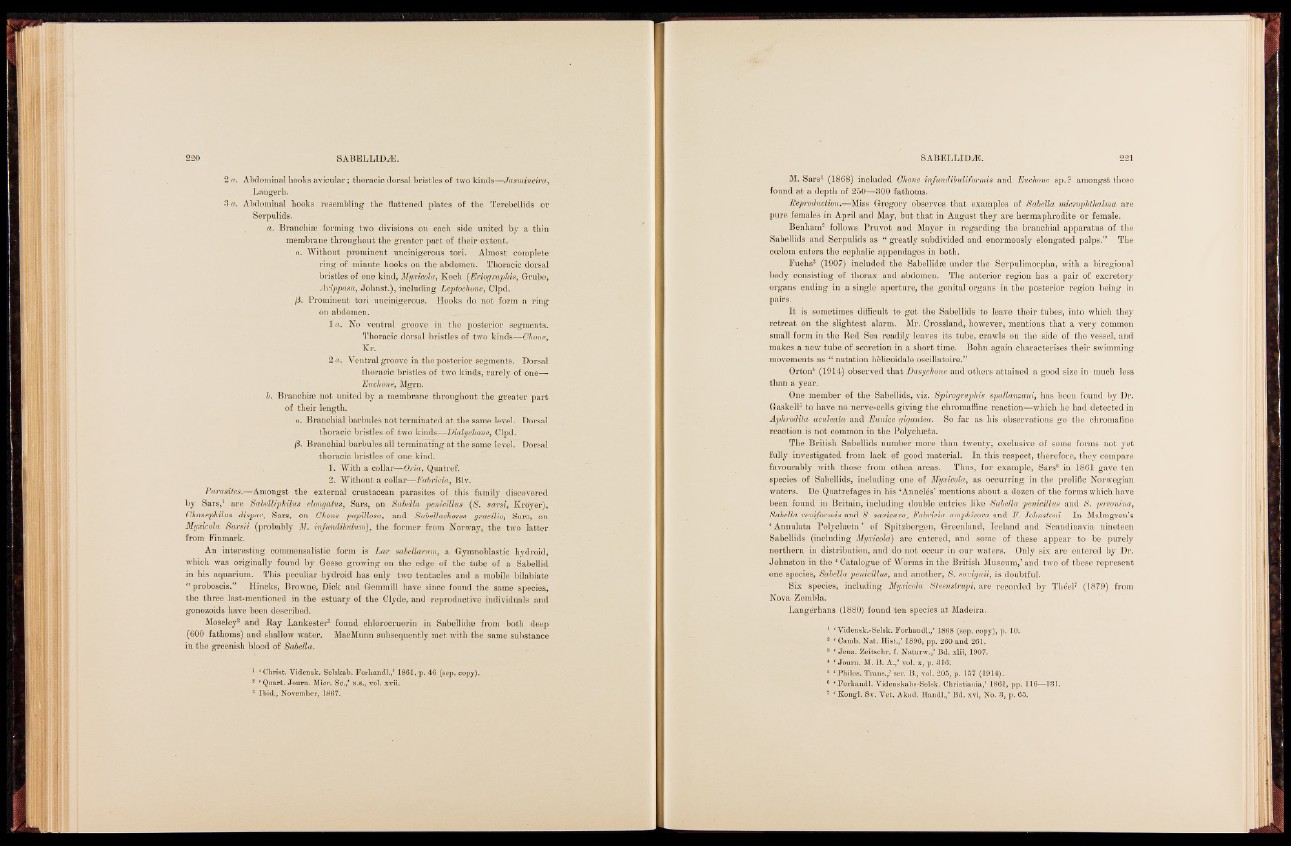
2 a. Abdominal hooks avictilar; thoracic dorsal bristles of two kinds—Jasmineira,
Langerh.
3 a. Abdominal hooks resembling the flattened plates of the Terebellids or
Serpulids.
a. Branchiae forming two divisions on each side united by a thin
membrane throughout the greater part of their extent.
a. Without prominent uncinigerous tori. Almost complete
ring of minute hooks on the abdomen. Thoracic dorsal
bristles of one kind, Myxicola, Koch (Enographis, Grube,
Arippasa, Johnst.), including Leptoclione, Clpd.
(3. Prominent tori uncinigerous. Hooks do not form a ring
on abdomen.
1 a. No ventral groove in the posterior segments.
Thoracic dorsal bristles of two kinds—Ghone,
Kr.
2 a. Ventral groove in the posterior segments. Dorsal
thoracic bristles of two kinds, rarely of one—®
Euchone, Mgrn.
b. Branchiae not united by a membrane throughout the greater part
of their length.
a. Branchial barbules not terminated at the same level. Dorsal
thoracic bristles of two kinds—JDialychone, Clpd.
(3. Branchial barbules all terminating at the same level. Dorsal
thoracic bristles of one kind.
1. With a collar—*-Oria, Quatref.
2. Without a collar—Fabncia, Blv.
Parasites.—Amongst the external crustacean parasites of this family discovered
by Sars,1 are Sabelliphilus elongatus, Sars, on Sdbella penwillus (8. sarsi, Kroyer),
Ghonephilus dispar, Sars, on Ghone papillosa, and Sabellacheres gracilis, Sars, on
Myxicola Sarsii (probably M. infundibidum), the former from Norway, the two latter
from Finmark.
An interesting commensalistic form is Lar sabellamm, a Gvmnoblastic hydroid,
which was originally found by Gosse growing on the edge of the tube of a Sabellid
in his aquarium. This peculiar hydroid has only two tentacles and a mobile bilabiate
“ proboscis.” Hincks, Browne, Dick and Gemmill have since found the same species,
the three last-mentioned in the estuary of the Clyde, and reproductive individuals and
gonozoids have been described.
Moseley3 and Ray Lankester3 found chlorocruorin in Sabellidas from both deep
(600 fathoms) and shallow water. MacMunn subsequently met with the same substance
in the greenish blood of Sdbella.
1 ‘ Christ. Vidensk. Selskab. Forhandl./ 1861, p. 46 (sep. copy).
3 ‘ Quart. Journ. Micr. Sc./ N.s., vol. xvii.
8 Ibid., November, 1867.
M. Sars1 (1868) included Ghone infundibuliformis and Euchone sp. ? amongst those
found at a depth of 250—300 fathoms.
Reproduction.—Miss Gregory observes that examples of Sdbella microphthalma are
pure females in April and May, but that in August they are hermaphrodite or female.
Benham3 follows Pruvot and Mayer in regarding the branchial apparatus of the
Sabellids and Serpulids as “ greatly subdivided and enormously elongated palps.” The
coelom enters the cephalic appendages in both.
Fuchs3 (1907) included the Sabellidse under the Serpulimorpha, with a biregional
body consisting of thorax and abdomen. The anterior region has a pair of excretory
organs ending in a single aperture, the genital organs in the posterior region being in
pairs.
It is sometimes difficult to get the Sabellids to leave their tubes, into which they
retreat on the slightest alarm. Mr. Crossland, however, mentions that a very common
small form in the Red Sea readily leaves its tube, crawls on the side of the vessel, and
makes a new tube of secretion in a short time. Bohn again characterises their swimming
movements as “ natation h&licoidale oscillatoire.”
Orton4 (1914) observed that Dasychone and others attained a good size in much less
than a year.
One member of the Sabellids, viz. Spirographis Spallanzani, has been found by Dr.
Gaskell5 to have no nerve-cells giving the chromaffine reaction—which he had detected in
Aphrodita aculeata and Eunice gigantea. So far as his observations go the chromafine
reaction is not dommon in the Polychseta.
The British Sabellids number more than twenty, exclusive of some forms not yet
fully investigated from lack of good material. In this respect, therefore, they compare
favourably with those from othea areas. Thus, for example, Sars6 in 1861 gave ten
species of Sabellids, including one of Myxicola, as occurring in the prolific Norwegian
waters. De Quatrefages in his ‘Anneles’ mentions about a dozen of the forms which have
been found in Britain, including double entries like Sdbella penicillus and S. •pa.vonina,
Sdbella reniformis and S. saxicava, Fabricia. amphicora and F. Johnstoni. In Malmgren’s
‘Annulata Polychseta’ of Spitzbergen, Greenland, Iceland and Scandinavia nineteen
Sabellids (including Myxicola) are entered, and some of these appear to be purely
northern in distribution, and do not occur in our waters. Only six are entered by Dr.
Johnston in the ‘ Catalogue of Worms in the British Museum,’ and two of these represent
one species, Sdbella penicilhis, and another, S. savignii, is doubtful.
Six species, including Myxicola Steenstrupi, are recorded by Theel7 (1879) from
Nova Zembla.
Langerhans (1880) found ten species at Madeira.
1 ‘ Vidensk.-Selsk. Forhandl./ 1868 (sep. copy), p. 10.
3 ‘ Camb. Nat. Hist.,’ 1896, pp. 260 and 261.
8 ‘ Jena. Zeitschr. f. Naturw./ Bd. xlii, 1907.
4 ‘ Journ. M. B. A.,’ vol. x, p. 316.
6 ‘Philos. Trans./ sei\ B., vol. 205, p. 157 (1914).
8 ‘Forhandl. Videnskabs-Selsk. Christiania/ 1861, pp. 116—131.
7 ‘Kongl. Sv. Yet. Akad. Handl./ Bd. xvi, No. 3, p. 65.